Cloning is Not Science Fiction
Plant cloning is well known in the form of stem cuttings, tubers such as potatoes or runners such as strawberry plants where new plants are produced without the use of seed production. Most commercial onions are produced from seeds but a few less commercial varieties such as shallots, multiplier onions or tree onions are almost exclusively clones formed by division or topsets. Occasionally, some of these varieties produce seed that can be used to invigorate the variety and enable the genetic blueprint to reset and adapt itself.
Sterile Tree Onions
Until recently I was happy to believe the hype that tree onions (allium proliferum) are a hybrid variety of the common onion (allium cepa) and the bunching welsh onion or japanese bunching onion (allium fistulosum) and as such were sterile and never produced seed.
This is a very reasonable assumption as seed producing varieties have never been available and all available tree onions are supplied as "sets" or "top sets".
This would imply that the different varieties developed as either:
- sports where natural genetic mutations have allowed the plant to adapt to its surroundings and differs from its ancestor by the presence of the mutated gene or
- Distinctly separate Hybrids of A.cepa and A.fistulosum where genetically diverse parent plants have spontaneously cross pollinated to produce the differing varieties found across differing continents
Finnish Air Onions - Fertile Seed Producing Tree Onion
A cross between 2 species AA and BB that each provide half of the genetic material could, in theory, provide offspring that can also cross with one another: AB x AB to give 4 general outcomes in the simplest form: AA, AB, BA, BB.
Cloning For Season to Season Survival
Over time, the genetic material that favours local survival should dominate and give rise to a relatively stable plant that thrives in its local environment. This seems to be the case with the Finnish Air Onions as the plants mostly produce clones of themselves.
Multiplying Bulbs and Topsets
The below ground bulb can multiply just like a shallot or potato onion while above ground, the flower stalk usually produces miniature bulbs or bulbils that can be grown into genetic replicas of the parent plant. This helps ensure survival from one season to the next.
Genetic Diversity - Randomness
Very occasionally, the plant can produce fertile seeds that allow a degree of randomness to the genetic makeup. This allows the plant to find a way to adapt to the local environment while providing a chance for protection against pests and diseases. Certain seedlings will thrive while poorer adapted seedlings fail to mature. This can give rise to "landraces" which are subtly different from one another yet still a version of the original variety.
Decades or Centuries of Cloning
The origin of the various tree onions are difficult to trace back. The mid 19th century seems to have been the heyday of commercial production and availability from various seed merchants. If the plants are only available as clones then the plants available today are clones of those original plants.
Virus and Disease
Each season exposes the plant to viruses and diseases that can weaken the plant and embed themselves into the genetic makeup of the plants. This process can slowly reduce vigour and subsequent generations are likely to be smaller.
The Potato Famine - Single Variety Risk
There is also the risk of a virus or disease that can overcome the plant`s natural defences. This was the reason for the Irish potato famine of 1845 onwards where a potato blight that originated in Mexico was able to spread rapidly across America and Europe to Ireland where the "lumper" potato variety was highly susceptible to the Phytophthora infestans fungal blight. You may be surprised to learn that even though that particular variety failed so drammatically and lead to millions starving, it survived and is still available today.
Nature Finds A Way
Anecdotal evidence suggests that on very rare occasions, a variety that usually propagates vegetatively can spontaneously produce viable seed. This often seems to occur when the species is put under stress and "feels" the need to diversify. The variety may still be at risk but does have a survival mechanism in place.
I`Itoi Onions - Infrequent Flowering
An interesting onion where this phenomenon occurs is the i`itoi (pronounced: ee ee toy) onion, a very early form of clumping multiplier onion or shallot found in the Sonora desert. It seems to have been introduced to the area by the Jesuit priests during the early 1600s. It is usually a very prolific multiplier. One onion can split multiple times to produce a cluster of up to 100 bulbs. On very rare occasions the onions will spontaneously flower. You can grow these for years and may never see them flower.
Terminology
Landrace
From the german landrasse or country breed to signify a plant or animal variety that has uniquely adapted to its local climate. It may not always be the most prolific variety but is generally stable to the local climatic conditions and able to tolerate adverse local seasons better than non-adapted varieties

 Allium Proliferum (1681)
Allium Proliferum (1681)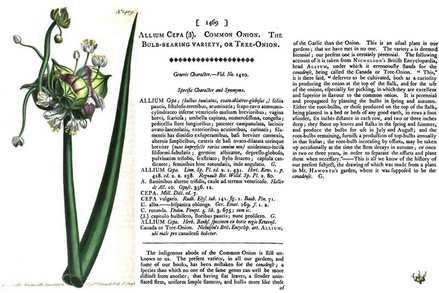 Early Tree Onion Illustration (1812)
Early Tree Onion Illustration (1812)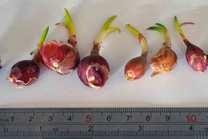 Red Bulbils
Red Bulbils
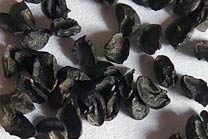 Tree Onion Seeds
Tree Onion Seeds
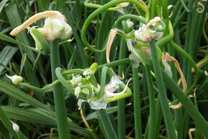 Tree Onion "Flowers"
Tree Onion "Flowers"
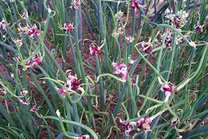 Red Top Sets
Red Top Sets